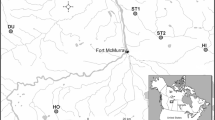Abstract.
Parasites of host guilds, such as mud snails (five species), benthic crustaceans (six species) and small-sized fishes (Pomatoschistus microps, Gasterosteus aculeatus, Pungitius pungitius, young Pleuronectes flesus), were investigated in the Other Bight off West Fehmarn (Kiel Bight, German Baltic Sea). The hosts, especially the herbivorous Hydrobia spp, Gammarus spp and Idothea chelipes, attained extremely high densities in three habitats (Enteromorpha belt, Fucus belt, sandy bottom), which may be a consequence of high eutrophication. Fish as carnivores and several helminths as parasites can profit from these massive appearances – more than 5,000 Hydrobia mud snails/m2 or 282 I. chelipes/m2. Prevalences of mud snails peaked in summer, by up to 30% extra, whereas species of benthic crustaceans attained increases of 47–100%, fish 57–100%. The most abundant helminths were the digeneans Maritrema subdolum, Microphallus claviformis and Asymphylodora demeli in Hydrobia spp, Maritrema subdolum, Microphallus papillorobustum, Levinseniella brachysoma and Podocotyle atomon in benthic crustaceans and Cryptocotyle concavum, Podocotyle atomon and Brachyphallus crenatus in fish. The copepod Thersitina gasterostei was also abundant in sticklebacks. The density of parasites (number/m2) peaked in summer, with more than 10,000 Maritrema subdolum metacercariae in I. chelipes from the Fucus belt and more than 1,000 in I. chelipes from the Enteromorpha belt or the sandy bottom. There was a clear seasonality in the appearance of digeneans in G. locusta, G. salinus and I. chelipes infected by M. subdolum and Gammarus spp infected by L. brachysoma and P. atomon. Therefore, the Orther Bight may be a epizootiotope for M. subdolum and C. concavum, i.e. a habitat with an extreme infection rate which can endanger the population of the host. Idothea chelipes also has a high infection potential to the final hosts of M. subdolum, crustacean-feeding birds. Similar relationships were found between the bird digenean C. concavum and the common goby Pomatoschistus microps. The infection mechanisms of both benthic crustaceans and small-sized fish follow the rule of predation in two steps: dispersion and accumulation.
Similar content being viewed by others
Author information
Authors and Affiliations
Additional information
Electronic Publication
Rights and permissions
About this article
Cite this article
Zander, D.C., Koçoglu, Ö., Skroblies, M. et al. Parasite populations and communities from the shallow littoral of the Orther Bight (Fehmarn, SW Baltic Sea). Parasitol Res 88, 734–744 (2002). https://doi.org/10.1007/s00436-002-0652-1
Received:
Accepted:
Issue Date:
DOI: https://doi.org/10.1007/s00436-002-0652-1



